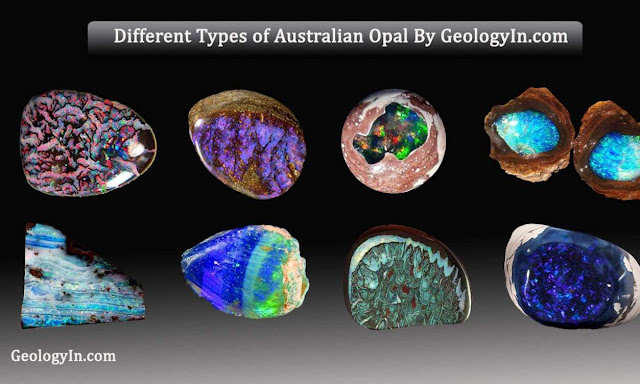Unearthing the Fire of the Eromanga Sea: The Enduring Legacy of Australian Opal
 Australia, a land of ancient mysteries and vibrant landscapes, holds a secret deep within its heart: the mesmerizing opal. As the nation’s gemstone, Australia commands the global opal market, boasting an estimated 95% of the world’s precious opal supply and potentially housing the lion’s share of global reserves. This geological treasure trove, intricately linked to the ancient Eromanga Sea, whispers tales of a time when central Australia was submerged, a crucible for the formation of these iridescent gems.
Australia, a land of ancient mysteries and vibrant landscapes, holds a secret deep within its heart: the mesmerizing opal. As the nation’s gemstone, Australia commands the global opal market, boasting an estimated 95% of the world’s precious opal supply and potentially housing the lion’s share of global reserves. This geological treasure trove, intricately linked to the ancient Eromanga Sea, whispers tales of a time when central Australia was submerged, a crucible for the formation of these iridescent gems.
While other regions like Mexico, Ethiopia, and Brazil contribute to the opal narrative, and historical deposits in Slovakia and the Czech Republic once dominated the market, the sheer volume and quality of Australian opal remain unparalleled. This dominance stems from a unique confluence of geological events, a story etched in the Cretaceous sedimentary rocks of the vast Great Artesian Basin, a story that begins with the Eromanga Sea.
The Eromanga Sea: Cradle of Australian Opal
The narrative of Australian opal is inextricably tied to the Eromanga Sea, a vast inland sea that stretched across central Australia between approximately 122 million and 91 million years ago. This epicontinental sea, a shallow body of water teeming with life, laid the foundation for the opal deposits we cherish today. The sedimentary rocks deposited within this sea, rich in organic matter and derived from volcanic materials, became the primary host rocks for the opal formation.
The subsequent retreat of the Eromanga Sea marked the beginning of a prolonged period of weathering, a crucial phase in the opal’s genesis. For millions of years, until around 40 million years ago, central Australia experienced a subtropical climate reminiscent of the modern Amazon Basin. During this time, the water table remained close to the surface, and acidic conditions prevailed, facilitating the release of silica and iron from the host rocks.
From Sea to Arid Plains: The Transformation of Opal
As the climate transitioned to aridity around 40 million years ago, the water table gradually receded, and the groundwater became alkaline. This shift in conditions, coupled with mild tectonic activity around 24 million years ago, triggered the remobilization of the previously released silica. The subtle, long-wavelength surface folds created by this tectonic activity facilitated the lateral and vertical migration of silica, under the arid conditions.
The opal, in its nascent form, was preserved within the weathered profiles beneath the crests of these developing surface folds. The rapid lowering of the water table in these areas, due to tectonic uplift, and the presence of siliceous cap rocks that protected against erosion, contributed to the preservation of the opal. The final chapter in this geological saga unfolded over the last 10 million years, as dissection and scarp erosion exposed the opal-bearing weathering profiles.
The Unique Genesis of Australian Opal
The formation of precious opal in central Australia is a testament to the convergence of a unique set of geological events, a symphony orchestrated over 100 million years. These events can be summarized as follows:
- Deposition of volcanic-derived, organic-rich sediments during the Cretaceous period within the Eromanga Sea: This provided the essential host rocks for opal formation.
- Weathering under warm, wet, and acidic conditions from the Late Cretaceous to the mid-Eocene: This process liberated silica and iron from the host rocks.
- Remobilization of silica under warm, arid, and alkaline conditions during a period of tectonic instability in the Late Oligocene-Early Miocene: This facilitated the concentration and deposition of opal.
- Preservation of opal formation through the lowering of the water table: This protected the opal from erosion and weathering.
The Enigma of Opal Formation: Void Fill and Replacement
Despite the wealth of knowledge surrounding the geological history of the Great Artesian Basin and the Eromanga Sea, the precise mechanisms of opal formation, particularly at the micro-scale, remain shrouded in mystery. Questions linger about the role of bacteria and the intricate interplay of chemical processes within the weathering profile.
However, a general consensus has emerged regarding two primary styles of opal formation: void fill and replacement. Void fill involves the deposition of opal within existing cavities, particularly in ironstone. Replacement, on the other hand, entails the substitution of other materials, such as layer-silicate clays, gypsum, calcite, goethite, fossils, and organic matter, with opal.
The replacement of fossils with opal, often found in locations like Lightning Ridge, creates unique and stunning specimens, showcasing the intricate details of ancient life preserved in iridescent hues. Opalized freshwater mussel shells from this region, dating back 110 million years, offer a glimpse into the vibrant ecosystem that once thrived within the Eromanga Sea.
Excerpt from Article below from https://www.geologyin.com Click here for full article
Why Is Australian Opal Unique?
The opal is the National Gemstone of Australia. Australia currently produces approximately 95 per cent of the world’s precious opal and probably has almost all of the world’s opal reserves. The only other significant producers are Mexico, Ethiopia and Brazil although the deposits in Slovakia and the Czech Republic once provided the bulk of the world’s production for over 2,000 years. Other countries where opal has been recorded include Guatemala, Honduras, Nicaragua, the western USA and Canada, Indonesia, Turkey and Ethiopia.
The opal is almost exclusively located within Cretaceous sedimentary rocks of the Great Artesian Basin, which experienced a major phase of uplift in the Late Cretaceous with subsequent erosion removing a package of sedimentary rock up to 3 km in thickness.
Intense weathering resulted in extensive silicification at relatively shallow levels within the Tertiary regolith. However, despite a billion dollar industry and a well-constrained geological history of the basin, the formation of sedimentary opal and its uniqueness to the Australian continent are still very poorly understood.
The sedimentary opal deposits of central Australia occur along generally flat-lying horizontal layers within 30 metres of the earth’s surface. They are a product of a unique set of geological events which occurred over a 100 million year period. These events can be summarised as follows:
1- Between about 122 million years ago (Ma) and 91 Ma, central Australia was covered by a vast shallow epicontinental sea. The sedimentary rocks which were deposited in this sea were derived from volcanic rocks and were organic-rich. These formed the principal host rocks for opal deposits in central Australia.
2-Following surface exposure through lowering of the sea level, these host rocks were subject to a prolonged sub-tropical weathering regime until about 40 Ma. Central Australia probably looked not unlike today’s Amazon Basin. During this time, the water table was close to the surface and was acidic releasing silica and iron from weathering of the host rocks.
3-The climate became more arid from about 40 Ma and, as a result, water table levels gradually lowered and the groundwater became alkaline. Mild tectonism at 24 Ma
gave rise to subtle extremely long wavelength surface folds which facilitated both lateral and vertical migration under arid conditions of the earlier-released silica. Opal was preserved in the weathered profiles beneath the crests of the developing surface folds as water tables here lowered more rapidly due to tectonic uplift. Siliceous cap rocks discouraged erosion.
4- Over the last 10 million years, dissection and scarp erosion exposed the weathering profiles containing the opal.
Geologists believe that the volume of gems that have been produced over the past 150 years in Australia is but a minute fraction of the amount yet to be discovered.
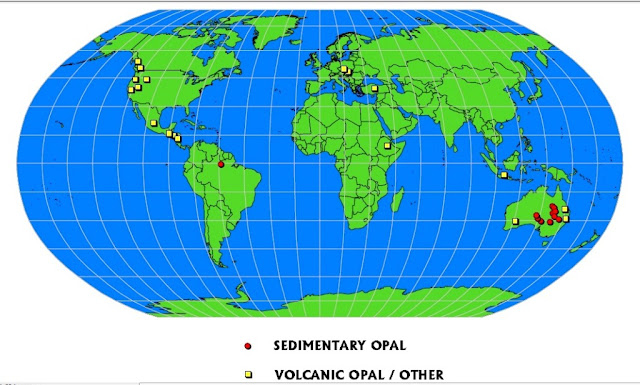 |
| Precious Opal Deposits of the World. credit: David Horton |
A unique combination of geological events appear to have taken place in central Australia over the last 100 million years to form precious opal. These are:
- Deposition of volcanic-derived organic-rich sediments over a 30 million year period during the Cretaceous.
- Weathering under warm wet acidic conditions from the Late Cretaceous to the mid-
Eocene which released silica and iron. - Remobilisation of the silica under warm arid alkaline conditions during a period of
tectonic instability during the Late Oligocene-Early Miocene. - Preservation of the opal forming in the weathering profile through lowering of the watertable.
There is still much that is not understood about the specifics of the genesis of precious opal particularly at the micro scale. How does it form in the weathering profile? For example, is bacteria involved? Irrespective of the method, there is now general consensus for two styles of opal formation – void fill and replacement.
Deposition of precious opal occurs mostly by replacement of layer-silicate clays, gypsum, calcite, goethite, fossils and organic material as well as by infilling of voids particularly in ironstone.
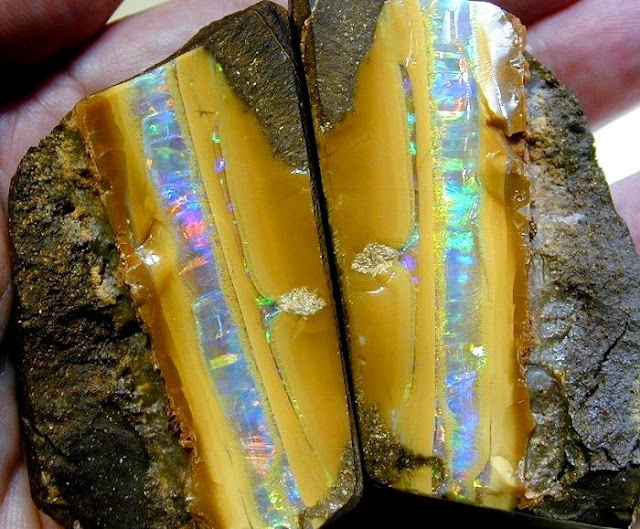 |
| This beautiful boulder opal split From Queensland, Australia. |
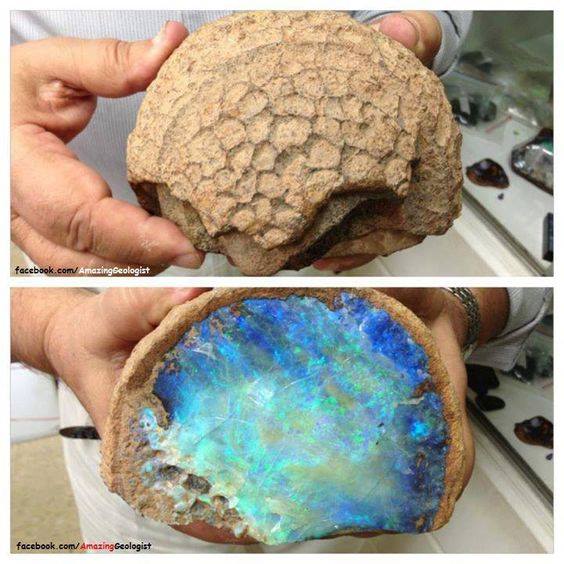 |
| ⚒ Opal Fossil Coral From Australia |
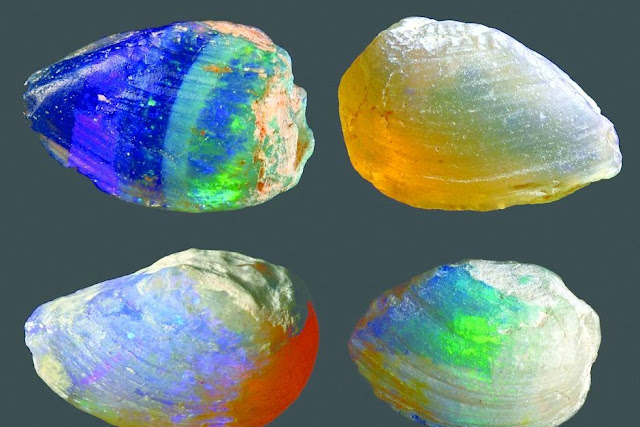 |
| Stunning Opalized freshwater mussel shells 110 million years old From Lightning Ridge, Australia |
Exploring the Diverse Facets of Australian Opal
The opal, with its captivating play of colors, is a gemstone of unparalleled beauty and diversity. Each piece is a unique work of art, reflecting the intricate geological processes that shaped it. Australian opal, in particular, is renowned for its exceptional quality and variety, showcasing a spectrum of colors and patterns that mesmerize and inspire.
- Black Opal: The most prized and valuable of all opals, black opal is characterized by its dark body tone and vibrant play of color. Lightning Ridge, in New South Wales, is the world’s primary source of black opal.
- Boulder Opal: Found predominantly in Queensland, boulder opal is characterized by its thin veins of precious opal embedded in ironstone matrix. This unique combination of opal and ironstone creates stunning patterns and textures.
- Crystal Opal: Characterized by its translucent to transparent body tone, crystal opal allows light to penetrate, revealing a dazzling display of color play.
- White Opal: With a white or light-colored body tone, white opal exhibits a more subtle play of color.
- Matrix Opal: Matrix opal is found where the opal is dispersed as infillings or cementing material throughout the host rock.
The Enduring Legacy of the Eromanga Sea and the Opal Industry
The Eromanga Sea, though long gone, has left an indelible mark on the Australian landscape and its economy. The opal industry, a testament to the enduring legacy of this ancient sea, contributes significantly to the nation’s wealth and cultural heritage.
The vast reserves of opal within the Great Artesian Basin, a direct consequence of the geological processes initiated by the Eromanga Sea, suggest that the industry’s future remains bright. Geologists believe that the gems extracted over the past 150 years represent only a fraction of the opal yet to be discovered.
The opal, a symbol of Australia’s natural beauty and geological richness, continues to captivate and inspire. Its iridescent hues, a reflection of the ancient Eromanga Sea, tell a story of time, transformation, and the enduring power of nature.
The opal, Australia’s national gemstone, is a testament to the unique geological history of the continent, a story intricately intertwined with the ancient Eromanga Sea. The confluence of geological events, spanning millions of years, has resulted in the formation of some of the world’s most exquisite opals.
The enduring legacy of the Eromanga Sea continues to shape the Australian opal industry, a testament to the enduring power of nature and the timeless beauty of these iridescent gems. As we delve deeper into the mysteries of opal formation, we gain a greater appreciation for the intricate processes that have shaped the Australian landscape and gifted us with these treasures.

